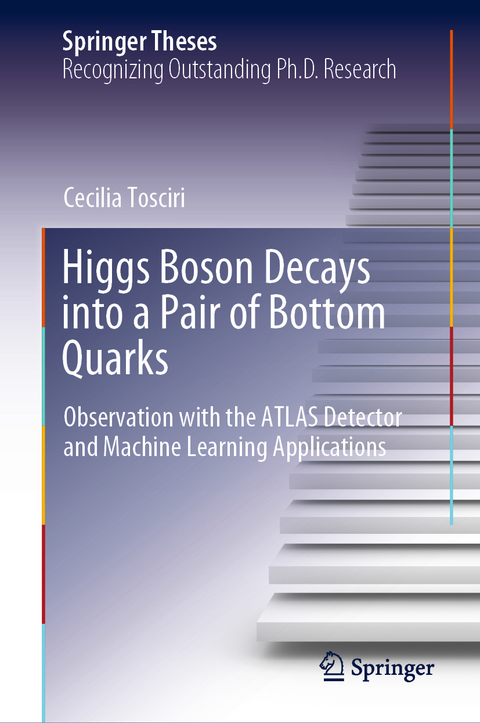
Higgs Boson Decays into a Pair of Bottom Quarks
Springer International Publishing (Verlag)
978-3-030-87937-2 (ISBN)
This thesis presents the analysis that led to the observation of the SM Higgs boson decay into pairs of bottom quarks. The analysis exploits the production of a Higgs boson associated with a vector boson whose signatures enable efficient triggering and powerful background reduction. The main strategy to maximise the signal sensitivity is based on a multivariate approach. The analysis is performed on a dataset corresponding to a luminosity of 79.8/fb collected by the ATLAS experiment during Run-2 at a centre-of-mass energy of 13 TeV. An excess of events over the expected background is found with an observed (expected) significance of 4.9 (4.3) standard deviation. A combination with results from other Hbb searches provides an observed (expected) significance of 5.4 (5.5). The corresponding ratio between the signal yield and the SM expectation is 1.01 +- 0.12 (stat.)+ 0.16-0.15(syst.).
The 'observation' analysis was further extended to provide a finer interpretation of the V H(H bb) signal measurement. The cross sections for the VH production times the H bb branching ratio have been measured in exclusive regions of phase space. These measurements are used to search for possible deviations from the SM with an effective field theory approach, based on anomalous couplings of the Higgs boson. The results of the cross-section measurements, as well as the constraining of the operators that affect the couplings of the Higgs boson to the vector boson and the bottom quarks, have been documented and discussed in this thesis.
This thesis also describes a novel technique for the fast simulation of the forward calorimeter response, based on similarity search methods. Such techniques constitute a branch of ML and include clustering and indexing methods that enable quick and efficient searches for vectors similar to each other. The new simulation approach provides optimal results in terms of detector resolution response and reduces the computational requirements of a standard particles simulation.
lt;p>Cecilia Tosciri received her Master in Physics in 2016 from the University of Pisa (Italy). For her Master's thesis research, she was based at the Fermi National Accelerator Laboratory (Batavia, USA), working on a refined measurement of the top quark mass with the CDF experiment. She then obtained her PhD in Particle Physics from the University of Oxford in 2020. During the PhD, her research with the ATLAS experiment at CERN was focused on the measurement of the Higgs boson properties. As a Marie Sklodowska-Curie fellow, she was also involved in an Innovative Training Network of the European Commission's H2020 Program, focused on machine learning techniques for data analysis in particle physics. Her PhD thesis was recognised with the 2020 ATLAS Thesis Award. She is currently a postdoctoral researcher at the University of Chicago (USA), and her research interests range from the commissioning of the new trigger system in ATLAS to the search for hints of New Physics.
Introduction.- Theoretical Introduction.- Machine Learning.- The LHC and the ATLAS Detector.- Physics Object Reconstruction.
| Erscheinungsdatum | 24.10.2021 |
|---|---|
| Reihe/Serie | Springer Theses |
| Zusatzinfo | XIX, 159 p. 84 illus., 76 illus. in color. |
| Verlagsort | Cham |
| Sprache | englisch |
| Maße | 155 x 235 mm |
| Gewicht | 427 g |
| Themenwelt | Informatik ► Theorie / Studium ► Künstliche Intelligenz / Robotik |
| Naturwissenschaften ► Physik / Astronomie ► Atom- / Kern- / Molekularphysik | |
| Naturwissenschaften ► Physik / Astronomie ► Hochenergiephysik / Teilchenphysik | |
| Naturwissenschaften ► Physik / Astronomie ► Quantenphysik | |
| Naturwissenschaften ► Physik / Astronomie ► Theoretische Physik | |
| Schlagworte | Approximate Nearest Neighbours • ATLAS Experiment • Bbottom Quarks • effective field theory • EFT • fast simulation • Frozen Showers • Hierarchical Navigable Small World • higgs • Higgs boson • HNSW • Inverted Index • Large Hadron Collider • LHC • machine learning • Particle physics • Similarity Search • Simplified Template Cross Section Framework • STXS |
| ISBN-10 | 3-030-87937-2 / 3030879372 |
| ISBN-13 | 978-3-030-87937-2 / 9783030879372 |
| Zustand | Neuware |
| Haben Sie eine Frage zum Produkt? |
aus dem Bereich


